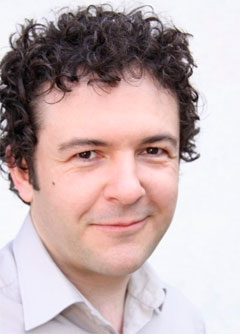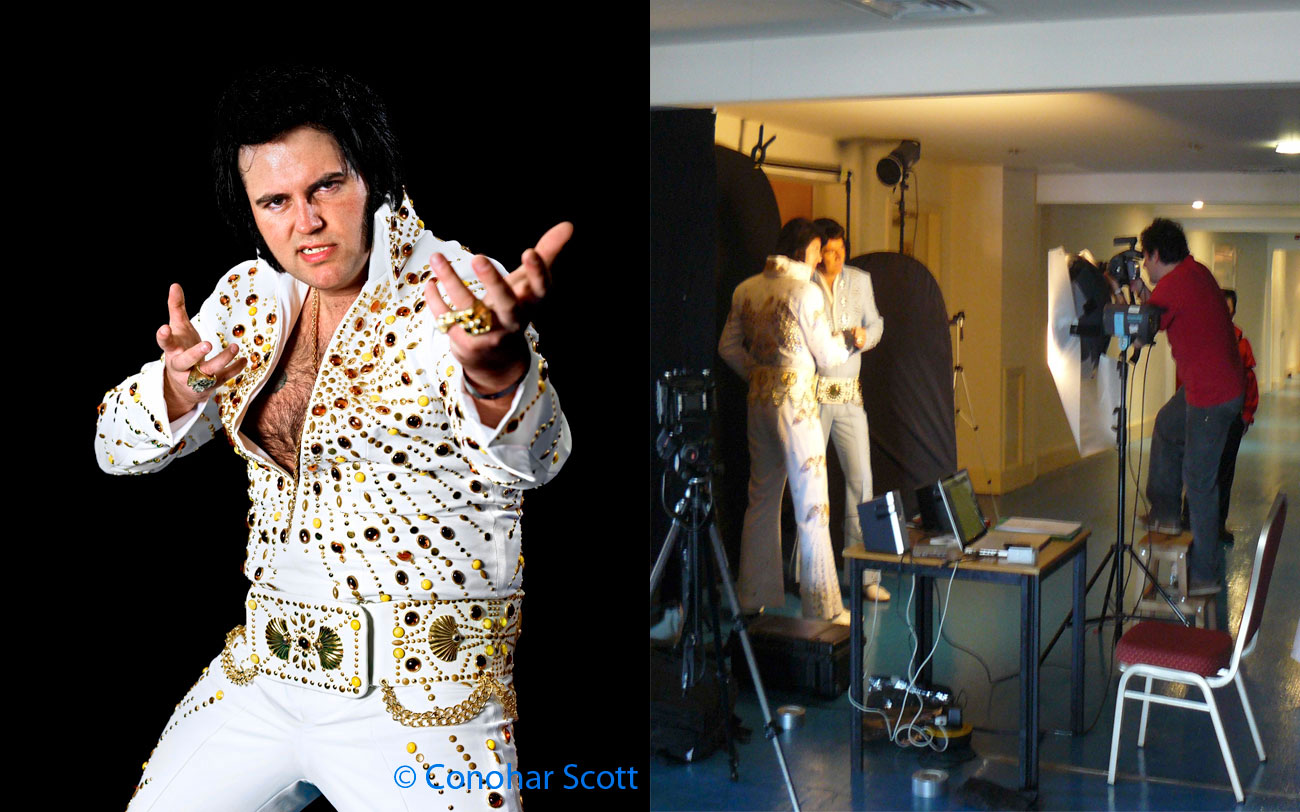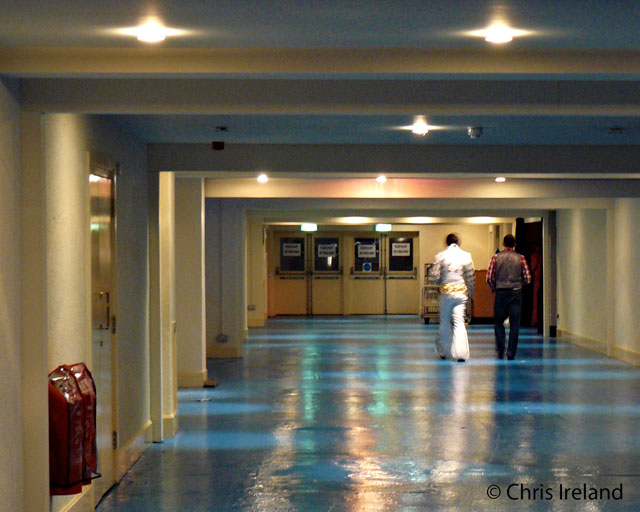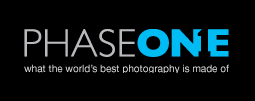Phase One P45+ is Graced by Elvis
Conohar Scott

In 2010 I was invited to sponsor a photographer Conohar Scott on a very unusual event in the first week of the New Year. After some thought I said yes!!. Conohar needed a high-end medium format system. As it got closer to the event I wondered what I had let my self in for. As I would assist Conohar, as he had not used a medium format digital system before and the event was 3 days Friday to Sunday evening.
It turned out to be one of the best projects I have ever supported, the content was just fascinating and Conohar is not only an excellent photographer he is a good laugh and easy to get on with.
The event was the Euro Elvis Competition held in Blackpool every year this year on Elvis’ 75th Birthday, the event was superb the acts and organisers were outstanding. I would go again as a spectator as it was so much fun!!!.
I posed some questions to Conohar about the concept of the shoot, on the equipment he used, and his first time using the software.
To see all the images go to http://www.conohar.com

I also managed to shoot a few images on the New scientific Achromatic Plus which you can see, go to
What is Graced by Elvis about and what brought you to this subject?
I’d been trying to gain access to the Elvis European Championships for a couple of years but for one reason or another the project just hadn’t come off for me. This year was a good time to begin, as it was the 75th anniversary of Elvis’ birthday. Like most people my age, I’m in my thirties, I had always been aware of Elvis but never really paid that much attention to him, however, years ago I remember being struck by a quote which said that if the population of Elvis Tribute Artists (ETAs) continued to grow at the same pace it would constitute a third of the world’s population by 2019. It’s obviously a crazy notion but it shows you how it’s taken off.
I did a little more research on the issue and I came to appreciate how global the phenomenon actually is, I mean the ETAs can compete for titles in Japan, The Philippines, Turkey, the UK and of course in the USA. Really, I became interested in how far you could stretch the concept of Elvis and still pull it off – I’m fascinated by the idea of a Japanese Elvis, a female Elvis or a black Elvis.
What was the event like? Can you describe it?
When you go to a convention like the European Championships there are many complex dynamics happening at the same time. For a lot of the performers it’s a career, they might charge around about £500 for a show and winning a title just increases that. The fans are different; I mean there’s definitely a hardcore element look and act as if they were in a Gospel church meeting and being that it was Elvis’ birthday there was definitely an element of invoking the Spirit of Elvis, that’s why I called the project Graced by Elvis. However, to be around so many Elvii is also to be graced in many other ways. Some contestants had flown from New Zealand, Malta, Germany and even Qatar but they all shared one thing in common, a kind of gentility, as if in wearing those expensive and exquisite costumes they took on a role and a responsibility to be like Elvis. The costume itself gave the performer a lot of confidence and so I really did get them dancing and moving on my set!

Why did you use Phase One for this project?
When it comes to digital backs and medium or large format photography there really are only a couple of companies to choose from. I knew Phase One was the market leader in the field and I was keen to see how the products could help me out in what was a very challenging project. The European Elvis Championships come once a year on the anniversary of Elvis’ birthday and they’re held in a hotel in Blackpool. I knew that the community of fans and performers would be very suspicious of a photographer coming in to the event and that the location itself would be challenging to work in.
I had to erect a studio setup in a corridor backstage and I wanted to shoot the subjects as they came off stage, all hyped up and covered in sweat. Time would be important, there would only be a few minutes between contestants, so I needed to be sure I had the shot. Also, I wanted to shoot the subjects three quarter length in a tight space. My solution was to use the Phase One 645DF and the 70-150mm f4.5 AF lens. The project was shot at an aperture of f8 and at the flash sync speed of 1/125 (ISO 100). I was surprised how much a performer could move and still be photographed without blur at that sync speed.
I used the P45+ digital back, so I knew that I would have a TIFF of around 230MB at 16 BIT. The fact that the P45+ gives files that have really no detectable noise with a huge dynamic range of 12.5 f-stops, meant that I was confident I could produce large canvasses for exhibition purposes that would really stand up on enlargement. When you consider that the sensor in the P45+ is almost a full frame 6x4.5cm with a Lens factor of 1.1 ratio , it really puts the Phase One system in perspective compared to any full frame 35mm system. I just wouldn’t consider shooting an art project on a DSLR but the P45+ digital back just gives you that confidence that you’ll end up with an image you can rely on to look great.

Would you wish to use film or a DSLR again after trying the Phase One products?
I’m a total convert, not to digital photography necessarily- I’ve never liked DSLRs, but to the workflow system that Phase One offers. Every step of the process shouts quality. The 645DF camera system is so easy to use as all the programming on a DSLR is essentially shifted on to the settings of Capture One; so what your left with is good, old-fashioned, medium format photography but with the added bonus of fast focusing with the new generation of AFD lenses. The new generation DF body is 30% faster with the AFD & New Leaf Shutter lenses in their response than on the older AF body. I also found that the new DF body has a more refined response at the point of shutter release so the effect is much quicker, more intuitive.
For a project like Graced by Elvis, where you essentially have a portable studio setup with three mono lights and subjects who are continually moving, being able to see the shot in live-time is a lifesaver! It gives you the ability to know you’ve got the shot without wearing yourself or your subjects into the ground needlessly. At the end of the day, I only had a couple of minutes with each performer but getting that shot was crucial.
Our setup was so good that sometimes I had the shot after just a couple of clicks and the performer could be shown the image there and then. You can’t underestimate how much confidence this gives you as a photographer but also the influence it has on your subjects or onlookers. The Elvis community is very suspicious of photographers and how they are portrayed, so the fact that the whole process was out in the open, really helped overcome that resistance. I just wouldn’t consider shooting a project like this in any other way to be honest.
How did you find working with Capture One
I was shocked by it. It seems such a simple application that it’s very easy to overlook how powerful the software actually is. Basically, Capture One is very good at unlocking the potential of that RAW file so by the time you end up taking that image in to Photoshop a lot of the hard work has already been done.
With this project, the white jumpsuits often had areas of cyan at points where the modeling lamp was falling off a little. It was so easy to de-saturate the clothing and neutralize the white without loosing any detail in exposure with the colour editor. I also found that sometimes to achieve the look you want, you have to go back into Capture One, change the settings and output another version of the image. This is easy- it takes just minutes but try doing that when scanning a negative or transparency! Personally, I’ve never been brilliant at scanning and I think that either means you have to pay an expert to do it or accept certain problems. Capture One really does give you the ability to get a full dynamic range from one file.
Elvis has left the building












